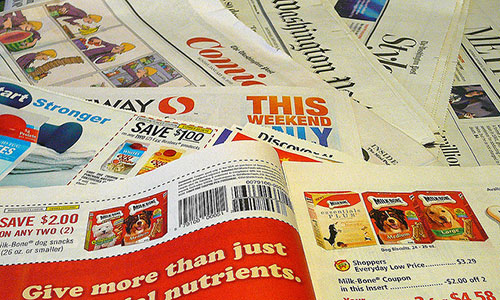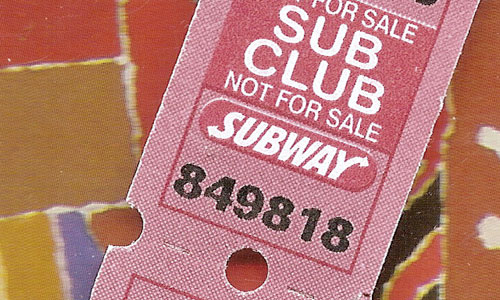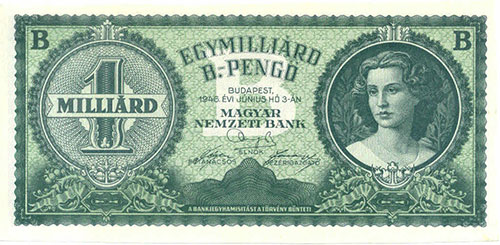Your Money Is Worthless Here
From coupons to Zimbabwean dollars, sometimes currency turns out to be worth a lot less than it initially seems.

Why coupons always tell you they have a nearly worthless cash value
You have to be really hard up to try to exchange 100 coupons for Fancy Feast for the penny in cash value you can get in return. You'd probably have more luck finding a penny on the street than finding 100 coupons for cat food, yet it's still theoretically possible. But why?
According to Mental Floss, two factors are at play. First off, manufacturer's coupons haven't been around forever—only since the 1890s, in fact, when C.W. Post started putting the coupons on packages of Grape Nuts—and they didn't achieve true widespread popularity until the 1970s, due to the popularity of a coupon variant called trading stamps. Trading stamps were the 1930s version of reward cards—except, instead of saving the value on a piece of secure plastic, you filled an entire book up with stamps, and those stamps could be used to buy stuff in catalogs.
As a result, trading stamps had nominal value, which led states to pass laws requiring those stamps to list their exchange prices.
Today, these stamps are largely a thing of the past, though their spirit remains alive as a part of programs like Labels for Education, which give the eventual rewards to local schools that can collect large numbers of labels en masse.
But as a result of this weird past, a few states still have rules requiring coupons to list their actual monetary value, which mean we all know how much a coupon is technically worth when transferred to real money.
The answer to that question: Not much.
"Now, they're a very vocal part of your customer base, and they don't like it when you stop giving them that reward. But the percentage of customers who actually enjoyed the benefit of that, our view was we were better off taking those dollars and investing them in better prices for all of our customers rather than rewarding just a select segment of our customers."
— Kroger Chief Financial Officer Michael Schlotman, defending the company's 2013 decision to end its offering of double coupons in some markets—a move that pissed off the extreme couponers of the world to that some of them pledged never to visit a Kroger store ever again. That's despite the fact that the coupon change came with a significant price cut.

The black market for Subway's Sub Club
For about two decades, Subway had turned the pre-history of trading stamps into a cult following stronger than Jared could ever muster. But as customers found out in 2005, free lunch has its limits.
In the 1980s, the sandwich shop chain had launched its Sub Club, in which people who visited the company's many restaurants could grab a little stamp offering evidence they frequently ate six-inch ham sandwiches. It was simple. It was effective. And it gave a raison d'être to the lowly stamp, which had become something of a second-class citizen compared to the coupon.
But in 2005, the company abruptly ended the program, blaming fraud for turning what was a perfect money-making opportunity into a money-losing proposition.
With computer printers and scanners becoming more common, people were starting to take the stamps, copy them, print them out, and put them on eBay. And since the stamps were simply designed, they were a lot easier to rip off than, say, Benjamins.
“It's possible some of the stamps got by and we didn’t even know,” company spokesman Kevin Kane told the Associated Press back in 2005. “It's possible we don’t even know the extent of it.”
Customers were angry. One 2005 petition put the situation as such:
On behalf of the millions of Subway customers world wide, we the undersigned feel compelled to stop the heinous act of removing Subway Stamps from circulation. We feel that subway stamps encourage heathy eating and living by novelty in and of its self. Without Subway Stamps Subway itself becomes just another health food restaurant. We feel that, even if only select sites return to continue distribution of Subway Stamps, that we the undersigned have succeeded in trying to save the world, one Subway at a time.
But in the end, the whole fiasco was probably worth it, because it led to better technology to track rewards. If Subway didn't fall on its face by handing out analog stamps, you wouldn't have Starbucks apps, Belly rewards, or other elaborate rewards systems.
And anyway, we all forgot about this debacle by the time $5 Footlongs came along.
$0

That time Hungary handed out currency by the sextillions
For all the mockery Zimbabwe got in the last decade for absurdly hyperinflated currency, it was nothing compared to what happened to Hungary's money between World War I and World War II. Between 1927 and 1946, the country's citizens paid for stuff using the pengő, which was originally meant to stabilize the country's currency.
As you can guess from the fact that we're writing about it, it didn't actually do that. In fact, it's the most hyperinflated currency of all time. Zimbabwe had a $100 trillion bill, which goes back 14 zeroes. In 1946, Hungary went so far as to print a $1 sextillion bill, only to drop the plan after apparently realizing that a $1 sextillion bill, which has 21 zeroes, is freaking insane.
To put this in easy to see terms, here's $100 trillion, written out:
$100,000,000,000,000
Now here's $1 sextillion:
$1,000,000,000,000,000,000,000
Now, there were other failed currencies of this nature—Mint.com has a blog post that covers failures like 1920s Germany, 1970s Chile, and 1990s Yugoslavia—but the common thread between these failed currencies is that much of the hyperinflation happens really fast, over the span of one to two years.
In the case of Hungary, most of the pain happened during a seven-month period in 1946, in which the currency's inflation rate exploded by 2 sextillion percent—and during which the country had come under Soviet influence immediately after World War II.
A 1993 New York Times article puts it in terms of sending a letter: "Parcel-post rates changed so quickly and became so complex that some stamps carried coded overprints that said, in effect, these stamps can be used to send a one-kilo parcel at whatever rate the postal clerk determines is in effect on the day of mailing."
Eventually they fixed the problem by replacing their pengős with the Hungarian forint, which itself got close to hyperinflation in the early 1990s, but never went over the edge. It's still in use today.
The sad irony of the decline of Zimbabwe's currency is that it's created a secondary market for the money, which is, again, worth nothing except sentimental value. Since 2011, a website called Zimbabwe Dollars has been selling the country's worthless currency for more than it was worth at its peak. The infamous $100 trillion dollar Zimbabwe bank note, worth about a single U.S. dollar at the currency's nadir, can be had for $53 U.S. dollars on this website.
That's depressing, obviously. But slightly more heartwarming is this BBC video of the citizens of Zimbabwe taking the currency and turning it into a fashion item.
Suffering for fashion, indeed.
:format(jpeg)/2018/11/r6zmrsyoav4xgbmptvpc--1-.gif)
/2018/11/r6zmrsyoav4xgbmptvpc--1-.gif)

/uploads/ernie_crop.jpg)